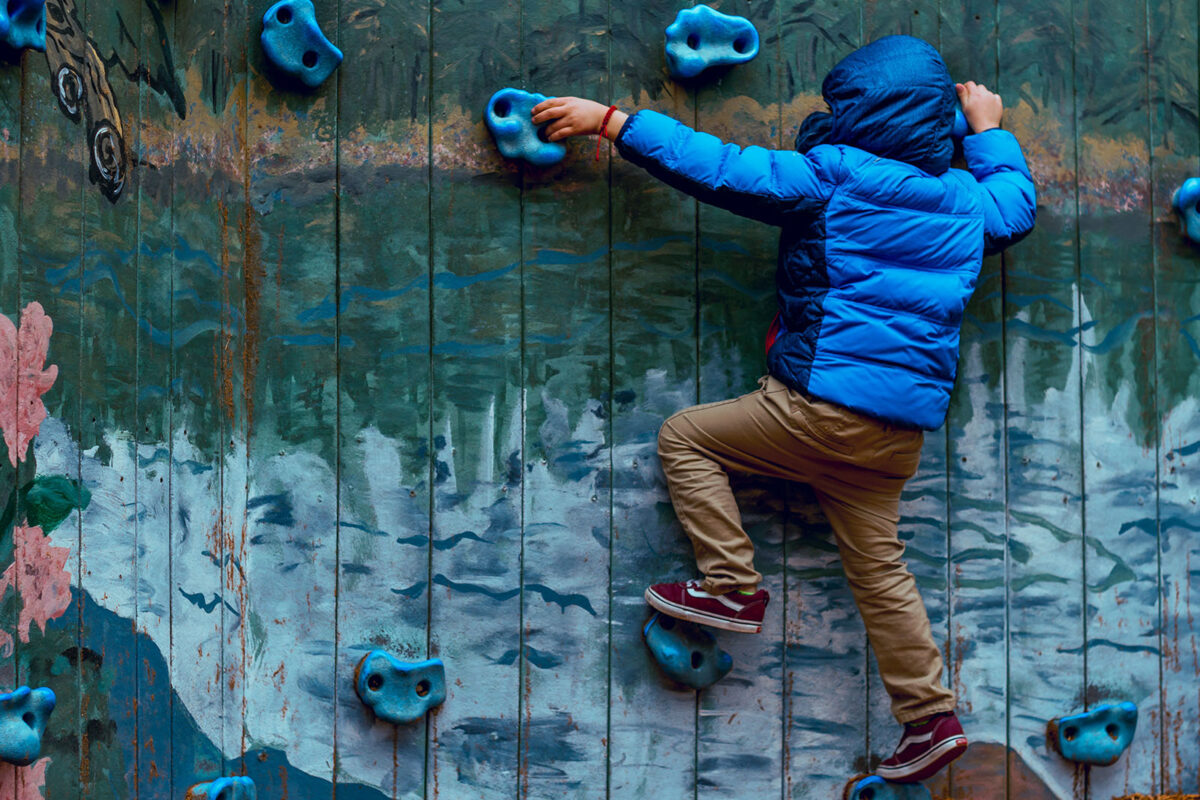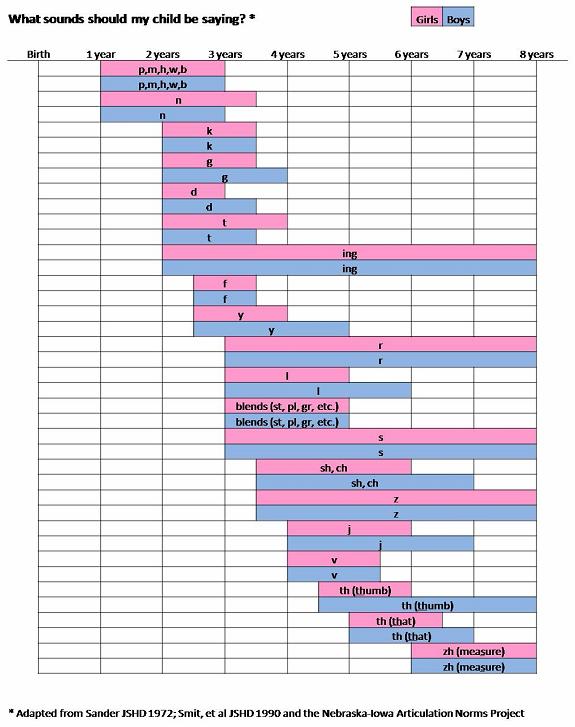Speech and Language Developmental Milestones
Articulation/Speech
Uses sentence-like intonations (jargon)
Some echolalia
Uses most vowels and consonants in jargon
Omits final consonants and some initial consonants
Basically unintelligible with exception of a few words
Words produced with consonant vowel-structure (bo/boat) emerge
Accurately imitates some words
Receptive Language
Follows simple one-step commands
Points to recognized objects (emerging nomination)
Begins to claim certain objects (emerging possession)
Points to one to three body parts on command
Identifies 2 or more objects or pictures from a group
Perceives others emotions
Recognizes own name
Understands “no”
Waves good-bye
Expressive Language
Uses 3 to 20 words
Vocalizes with gestures
Says “all gone” (emerging negation)
Answers question, “what’s this?”
Asks for “more” (emerging recurrence)
Imitates familiar words
Makes some environmental noises, familiar animals and machines
50% of utterances are nouns
Average length of responses are 1 to 2 words
Play
Solitary or onlooker play – self play
Continual walking activities
Begins running – stiff and awkward
Scribbles spontaneously with crayon
Can remove mittens, socks, hat
Puts object in and out of containers
Can figure out ways to overcoming some obstacles (opening doors, reaching high places)
Imitates many things (sweeping, combing hair – self-use)
Pulls toys; carries or hugs doll, teddy bear
Very rapid shifts in attention-especially expressed by gross motor shifts
Social Skills/Pragmatics
Bring objects to show an adult
Requests objects by pointing, vocalizing, or using word approximation
Solicits another’s attention vocally, physically and possibly with a word (“mommy”)
Gesturally request action/assistance (may give back wind-up toy to request activation)
Says “bye” and possibly a few conversational words such as “hi”, “thank-you” and “please”
Protests by saying “no,” shaking head, moving away, frowning or pushing objects away
Comments on object/action by directing listener’s attention to it
Acknowledges another’s speech by eye contact, vocally responding or repeating a word
Teases, scolds and warns using gestures plus a vocalization or word approximation
Articulation/Speech
Words increase in frequency,jargon almost gone by 2 years
Asks questions by raising intonation at end of phrase
Improvement in intelligibility – approximately 65% intelligible
Appearance of words produced with consonant – vowel – consonant structure (hot)
Receptive Language
Comprehends approximately 300 words
Follows simple two-step commands
Listens as pictures are named
Listens to simple stories – especially likes ones heard before
Points to five body parts on self or doll
Responds approximately to yes/no questions (head shake)
Object permanence fully acquired (knows something is there even when they cannot see it)
Discriminates food from other objects (unwraps candy before eating it)
Imitates only events that are present to the senses, not those from past experiences
Expressive Language
Uses approximately 50 recognizable words
Uses names of most familiar objects
Produces animal sounds or uses its name
Verbalizes toilet needs – may verbalize before, during or after act (closer to 2 years)
Identifies and names five or more pictures
Says own name on request – refers to self with full name
Verbalizes “no”
Verbalizes immediate experiences
Combines 2 words into phrases (~2 years) in noun Verb or noun+adjective form
Grammer and Syntax
Begins to use some verbs and adjectives
Follows directions using one or two spatial concepts (in/on)
Negation used in form of “no” (no bed)
Possessive emerging (daddy car)
Refers to self with pronoun and name (me Tommy)
33% utterances are nouns
Play
Parallel play begins – will play near others but not with them
Talks to self as he/she plays
Little social give-and-take – little interest in what others say or do buy hugs, pushes, pulls, snatches, grabs, defends rights by pulling hair or kicking
Does not ask for help; likes rapid shifts of attention
Transports blocks in a wagon rather that just building
Relates action to object or another person – washes, feeds combs doll in addition to self
Social Skills/Pragmatics
Names objects in front of others
Says “what’s that” to elicit attention
Begins to express commands, indicate possession and express problems
Much verbal turn-taking
Articulation/Speech
Approximately 50 – 70% intelligible
May omit final consonants; reduces consonant blends; substitutes one consonant for another
Receptive Language
Comprehends approximately 500 words
Listens to a 5 to 10 minute story
Carries out a series of two related commands
Identifies actions in pictures
Has concepts “one and “all”
Expressive Language
Uses approximately 50 – 200 intelligible words
Names 6 objects by use
Repeats two numbers correctly
Answers “where” questions
Answers “what” questions
Answers “what do you hear with?” meaning that they understand the function of body parts?
Grammer and Syntax
Articles “a” and “the” appear in sentences
Present progressive “ing” on verbs
Regular plural forms emerging (cat+cats)
Uses in/on correctly
Irregular past tense emerging
Uses some contractions in memorized form (don’t, can’t, it’s)
Appropriate use of at least two pronouns
Asks basic questions (“daddy gone?” “what’s this?”)
Understands concept of first- and second- person pronouns (I, you)
25% of utterances are nouns, 25% are verbs
Combines three to four words in subject + verb + object format
Average response is 2 – 3 words
Play
Parallel play dominates
Arranges doll furniture into meaningful groups and uses doll figures to act out simple themes (imaginative play)
Aligns three or more cubes to make a train; pushes train
Builds tower of six to seven blocks
Imitates drawing a vertical line
Sequences related actions in play such as preparing food for a doll, feeding it, wipes its mouth
Social Skills/Pragmatics
Engages in short dialogues
Expresses emotion
Uses attention-getting words, such as “hey”
Clarifies and ask for clarification
Begins to provide descriptive details
Articulation/Speech
Pronounces final consonants of words most of the time
Consonants mastered: m, n, ing, w, h, p, b, t, d, k, g, f
Is approximately 80% intelligible
Receptive Language
Comprehends approximately 1,200 words
Knows “in front of” and “behind” when object with a logical front and back are used
Identifies hard/soft, rough/smooth
Identifies circle and square
Responds to commands involving two actions or objects
Can match colors
Knows night and day
Expressive Language
Uses/says approximately 800 words
Responds appropriately to simple “how” questions
Can answer two-three questions, “what do you do when you are hungry/sleepy/cold?”
Beginning of question asking stage, mainly asks “what” and “who” questions
Names 8 to 10 pictures
States actions “I ran”
Supplies the last word of a line, “the apple is on the…(tree)”
Counts three objects, pointing to each
Average sentence length is four to five words
Follows basic commands with prepositional phrases “Put the block under the chair”
Grammar/Syntax
Begins to use “is” at the beginning of a question
Third-person singular present tense is emerging “he runs”
Uses contracted forms of modals (won’t, can’t)
Irregular plural forms emerging (child/children)
Uses “are” with plural nouns (boys are running)
Uses “and” as conjunction
Regular plural forms are consistent
Uses is, are and am in sentences
Play
Begins to play cooperatively with other children
Organizes doll furniture accurately and begins to use genuinely imaginative play
Reenacts experienced events such as a birthday party, baking cookies
Uses one object to represent another (stick = phone or sword)
Assumes the role of another person (parent, doctor, teacher)
Requests permission
Begins using language for fantasies, jokes, teasing
Corrects self, repairs conversation when others do not understand
Corrects others
Early story telling emerges
Articulation/Speech
Still some substitutions and distortions of consonants
Consonants mastered: m, n, ing, w, h, p, b, t, d,
Is approximately 70-80% intelligible
Receptive Language
Comprehends approximately 900 words
Listens to a 20 minute story
Knows own sex and difference
Knows in/on/under, big/little
Matches colors
Is cautious of common dangers
Has complicated, sequenced routines for daily activities; objects to change
Expressive Language
Expresses 500 intelligible words
Answers 6-7 agent action questions… “What runs?”
Answers simple “who, why, where, how many” questions
Yes/no questions emerging
Repeats sentences of six to seven syllables accurately
Grammar/Syntax
Auxiliary “is/am + ing” (girl is running)
Uses “is” + adjective (ball is red)
Regular past-tense verbs appear (walk/walked)
Uses “s” for possession (daddy’s car)
Uses pronouns – I, me, you, mine (he and she are emerging)
Negative “not” emerging
Uses contracted form of “is” (he’s running)
Uses imperatives (commands: go get it, don’t)
Adverbs of location emerging (here, there)
Understands “est” adjective marker (biggest)
Comprehends third-person pronouns (he, she)
Average phrase 3-4 words
Play
Dramatization and imagination begin to encounter play
Imitates drawing a circle/straight line
Interest in combining play things
Plays with others in small groups
Names own drawing
Watches cartoons on TV
Builds tower of none blocks
Social Skills/Pragmatics
Engages in dialogues increasing in length
Expresses emotion
Provides descriptive details
Becomes interested in cooperative play
Articulation/Speech
Consonants mastered: m, n, ing, w, h, p, b, t, d, k, g, y, f
Is approximately 90% intelligible
Receptive Language
Understands approximately 2800 words
Points to red, blue, yellow and green
Identifies crosses, triangles, circles, and squares
Stays with one activity for 11-12 minutes
Can follow a two-part unrelated command
Knows most body parts
Understands concepts of numbers up to 3
Answers questions about object’s functions
Expressive Language
Has a spoken vocabulary of approximately 900-2000 words
Asks many questions although more interested in how answers fit his/her own thoughts rather than just the explanation
Has a sentence length of 4-8 words
Talks about experiences at school, at friends’ homes, etc
Asks “who?” and why?”
Begins to use complex sentences
Uses contractions such as “it’s a” or “there’s a”
Uses grammatically correct sentences
Uses regular past tense correctly
Uses plural forms correctly
Can relate name and address along with age and gender
Basic Motor Milestones
Pushes, pulls and steers wheeled toys
Uses toilet independently
Skips to music
Releases objects with precision
Draws circles, diamonds and crosses
Enjoys cutting and pasting
Articulation/Speech
Consonants mastered: m, n, w, h, ing, y, b, p, t, d, k, g, f, v, l, sh, ch, th, blends
Receptive Language
Has a receptive vocabulary of approximately 20,000 words
Sequences numbers
Understands ‘left’ and ‘right’
Understands most concepts of time
Understands the meaning of most sentences
Expressive Language
Defines objects by there uses (“you eat with a fork”)
Asks ‘how’ questions
Answers verbally to ‘hi’ and ‘how are you?’
Uses past tense and future tense appropriately
Uses conjunctions
Names opposites
Sequentially names days of the week
Counts to 30 by rote
Counts 10 objects
Reduces sentence length to 4-6 words
Exchanges information and asks questions
Uses sentences with details
Accurately relays a story
Sings entire songs and recites nursery rhymes
Communicates easily with adults and other children
Uses appropriate grammar in most cases
Basic Motor Milestones
Prints a few capital letters
Builds complex structures with blocks
Buttons clothes, washes face and puts toys away
Reaches and grasps in one continuous movement
Catches a ball with hands
Makes precise marks with crayon, confining marks to a small area
Articulation/Speech
Consonants mastered: m, n, w, h, ing, y, b, p, t, d, k, g, f, v, l, sh, ch, th, r, s, z, r-blends, s-blends, l-blends
Receptive Language
Has a receptive vocabulary of approximately 20,000 words
Understands ‘left’ and ‘right’
Engages in conversations
Understands most concepts of time
Expressive Language
Names some letters, numbers and currencies
Sequences numbers
Uses increasingly more complex descriptions
Uses a sentence length of approximately 6 words
Recites the alphabet
Counts to 100 by rote
Uses most morphologic markers appropriately
Uses passive voice appropriately
Basic Motor Milestones
Shows reduced interest in writing and drawing
Draws recognizable man, tree, and house
Uses adult like writing, but it is slow and labored
Draws pictures that are not proportional
Colors within lines
Indicates well established right or left handedness
Dresses self completely
Follows advanced rhythms



